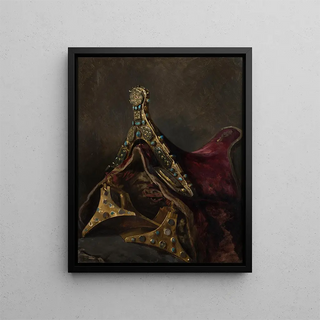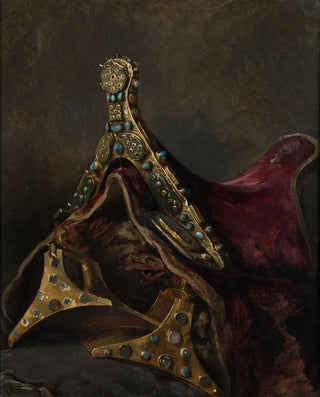Art print | Study of stirrups and a saddle - Stanisław von Chlebowski


View from behind

Frame (optional)
In the vast panorama of 19th-century art, the artwork "Study of stirrups and a saddle" by Stanisław von Chlebowski stands out for its finesse and attention to detail. This painting, although depicting an apparently utilitarian subject, transcends the simple study of everyday objects to become a true celebration of craftsmanship and savoir-faire. Through the meticulous representation of the saddle and stirrups, the artist invites us to immerse ourselves in a universe where each element tells a story, where beauty is hidden in the most ordinary objects. The soft light caressing the metallic surfaces and leather evokes an atmosphere that is both nostalgic and contemplative, encouraging the viewer to appreciate the richness of textures and forms.
Style and uniqueness of the work
Stanisław von Chlebowski's style is characterized by striking realism, which is evident in "Study of stirrups and a saddle." The artist manages to capture not only the physical appearance of the objects but also their essence, their character. Every detail is treated with a meticulousness that demonstrates his technical skill and deep respect for the depicted object. The composition is harmonious, balanced, and each element seems to find its place in a subtle visual dialogue. The carefully orchestrated play of light and shadow adds an almost sculptural dimension to the scene, transforming what could be perceived as a simple study into a work of art in its own right. This unique approach allows the viewer to appreciate not only the beauty of the objects but also the craftsmanship of the artisans who created them.
The artist and his influence
Stanisław von Chlebowski, born in Poland, managed to establish himself on the European artistic scene of the 19th century thanks to his ability to combine tradition and innovation. Influenced by the great masters of painting, he developed a style that is uniquely his own, blending realism and sensitivity. His work is not limited to mere representation but seeks to evoke emotions, to tell stories through everyday objects. Chlebowski was also a passionate advocate of Polish art, striving

Matte finish

View from behind

Frame (optional)
In the vast panorama of 19th-century art, the artwork "Study of stirrups and a saddle" by Stanisław von Chlebowski stands out for its finesse and attention to detail. This painting, although depicting an apparently utilitarian subject, transcends the simple study of everyday objects to become a true celebration of craftsmanship and savoir-faire. Through the meticulous representation of the saddle and stirrups, the artist invites us to immerse ourselves in a universe where each element tells a story, where beauty is hidden in the most ordinary objects. The soft light caressing the metallic surfaces and leather evokes an atmosphere that is both nostalgic and contemplative, encouraging the viewer to appreciate the richness of textures and forms.
Style and uniqueness of the work
Stanisław von Chlebowski's style is characterized by striking realism, which is evident in "Study of stirrups and a saddle." The artist manages to capture not only the physical appearance of the objects but also their essence, their character. Every detail is treated with a meticulousness that demonstrates his technical skill and deep respect for the depicted object. The composition is harmonious, balanced, and each element seems to find its place in a subtle visual dialogue. The carefully orchestrated play of light and shadow adds an almost sculptural dimension to the scene, transforming what could be perceived as a simple study into a work of art in its own right. This unique approach allows the viewer to appreciate not only the beauty of the objects but also the craftsmanship of the artisans who created them.
The artist and his influence
Stanisław von Chlebowski, born in Poland, managed to establish himself on the European artistic scene of the 19th century thanks to his ability to combine tradition and innovation. Influenced by the great masters of painting, he developed a style that is uniquely his own, blending realism and sensitivity. His work is not limited to mere representation but seeks to evoke emotions, to tell stories through everyday objects. Chlebowski was also a passionate advocate of Polish art, striving






